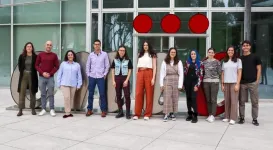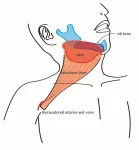(Press-News.org) SAN ANTONIO – A machine learning (ML) model incorporating both clinical and genomic factors outperformed models based solely on either clinical or genomic data in predicting which patients with hormone receptor (HR)-positive, HER2-negative metastatic breast cancer would have better outcomes from adding CDK4/6 inhibitors to endocrine therapy as first-line treatment, according to results presented at the San Antonio Breast Cancer Symposium (SABCS), held December 10-13, 2024.
While the use of CDK4/6 inhibitors combined with endocrine therapy have significantly improved outcomes in patients with HR-positive, HER2-negative metastatic breast cancer, Pedram Razavi, MD, PhD, the scientific director of the Global Research Program at Memorial Sloan Kettering Cancer Center and presenter of the study, noted that the responses to CDK4/6 inhibitors vary widely; some patients do markedly well, while others develop treatment resistance over time, and some derive no benefit at all.
“There’s a huge need in clinic to identify patients who may or may not benefit from adding CDK4/6 inhibitors at the time of metastatic diagnosis so that we can think about escalation and de-escalation strategies in advance,” Razavi said. “More accurate prediction of outcomes could also help some patients avoid unnecessary side effects and financial toxicity from escalated upfront approaches.”
Currently, Razavi explained, certain clinical features such as treatment-free interval (TFI), the time between the last dose of adjuvant endocrine therapy and the development of metastatic disease and measurable disease, are the main factors used to identify patients who may be at high risk of early progression on first-line CDK4/6 inhibitor combinations to identify candidates for escalation therapy. Razavi and his colleagues wanted to explore whether a multimodal ML model that included additional clinical and genomic factors could more accurately stratify patients.
Using OncoCast-MPM, a ML tool developed at Memorial Sloan Kettering, they generated three models to predict progression-free survival (PFS) with CDK4/6 inhibitors: one based on clinicopathological features (CF), another on genomic features (GF), and one integrating CF and GF (CGF). The models were developed using a training cohort of 761 patients with HR-positive, HER2-negative metastatic breast cancer who received first-line endocrine therapy with CDK4/6 inhibitor combinations and had tumor sequencing performed prior to treatment or within two months of the start of treatment with MSK-IMPACT, a test designed to detect gene mutations and match patients to treatments or clinical trials for actionable cancer targets. The performance of the model was tested on a holdout test cohort of 326 patients.
The models trained on CF and GF each identified three risk groups: high, intermediate, and low, with median PFS of 6.3, 15.2, and 24.5 months for CF, and 9.9, 18.1, and 23.1 months for GF, respectively.
The CGF integrated model identified four risk groups including two intermediate groups positioned between low- and high-risk categories. The median PFS was 5.3 months in the high-risk group and 29 months in low-risk group, with the intermediate groups showing median PFS of 10.7 and 19.8 months. Notably, the hazard ratio between the high- and low-risk groups was significantly higher in the CGF model (a 6.5-fold difference) compared to CF and GF models (3- to 4-fold difference), indicating a superior stratification of patients with the CGF model. Testing the holdout test cohort yielded nearly identical PFS and hazard ratio results, confirming the robustness of the models.
“All three models performed really well, surpassing the conventional clinical risk models based on a single or a few clinical features. But the power of the analysis shone when we started combining the clinical and genomic features together,” Razavi said.
The clinical and genomic factors that were selected by the ML model were mainly those known to be associated with outcomes or resistance to either CDK4/6 inhibitors or endocrine therapy. Key genomic predictors of poor outcomes were biologically plausible alterations such as TP53 loss, MYC amplifications, PTEN loss, RTK-MAPK pathway alterations, RB1 loss, whole genome doubling, and high proportion of loss of heterozygosity. The major clinical predictors included liver metastasis, TFI less than one year, progesterone receptor negativity, low estrogen receptor expression, and presence of visceral metastasis.
“All of these variables are potentially available when the patients are diagnosed with metastatic disease, making such ML models broadly applicable. The hope is to integrate these models in clinical trial design of escalation and de-escalation strategies potentially transforming how we approach treatment for newly diagnosed metastatic disease,” Razavi said. “Knowing that a patient on first-line CDK4/6 inhibitors is in the high-risk group could prompt the treating oncologists to implement closer disease monitoring and utilizing liquid biopsy and tumor-derived biomarkers to inform second-line treatment options and clinical trials. This could put us one step closer to staying ahead of breast cancer.”
Limitations of this study include its single-institution design, retrospective data analysis, and potential referral bias associated with specialized cancer centers. To address these challenges, Razavi and his team are validating the model using external data sets and aim to develop an online tool where physicians can input clinical and genomic data to receive patient-specific outcome predictions.
The study was indirectly and partially supported by the National Institutes of Health, U.S. Department of Defense, Susan G. Komen, Breast Cancer Research Foundation, AstraZeneca, Sophia Genetics, Novartis, and Tempus. Razavi reports consultant, advisory board, or advisor roles for AstraZeneca, Pfizer, Lilly/Loxo Oncology, Novartis, Tempus, Prelude Therapeutics, NeoGenomics, Natera, SAGA Diagnostics, Paige, Guardant Health, Myriad Genetics, and Foresight Diagnostics; and institutional grant/funding from Grail, Novartis, AstraZeneca, Biotheranostics, Tempus, NeoGenomics, Biovica International AB, Guardant Health, Personalis, Myriad Genetics, and Foresight Diagnostics.
END
COLUMBUS, Ohio – Researchers are shining a light on cancer cells’ energy centers – literally – to damage these power sources and trigger widespread cancer cell death.
In a new study, scientists combined strategies to deliver energy-disrupting gene therapy using nanoparticles manufactured to zero in only on cancer cells. Experiments showed the targeted therapy is effective at shrinking glioblastoma brain tumors and aggressive breast cancer tumors in mice.
The research team overcame a significant challenge to break ...
DALLAS, December 13, 2024 — The American Heart Association and Major League Baseball (MLB) brought cardiopulmonary resuscitation (CPR) and automated external defibrillator (AED) training to the League’s annual Winter Meetings held in Dallas this week. Attendees from all 30 Major League Clubs and many organizations across the baseball industry learned lifesaving skills needed to respond confidently and capably in the event of a cardiac emergency.
According to American Heart Association data, 9 out of ...
More than six million Americans are affected by Alzheimer’s disease, a form of dementia marked by accumulation of amyloid-β within the brain. Amyloid-β is a relatively small protein that forms toxic plaques in the brain contributing to the harmful effects of Alzheimer's disease. Another protein, hyperphosphorylated tau (pTau), also accumulates as toxic neurofibrillary tangles. Together, amyloid-β plaques and pTau tangles result in brain damage, neuroinflammation and ultimately brain death.
Gene expression studies have already identified ...
(Carlisle, Pa.) — A new study in the journal Scientific Reports offers a rare glimmer of hope in the face of climate change, suggesting glacial rivers and lakes may play a crucial role in mitigating the effects of methane, a powerful greenhouse gas that recent studies have shown emerging as glaciers melt in warming global temperatures.
This new study, led by Dickinson College Associate Professor of Environmental Studies Kristin Strock, looked at what happens when glaciers melt and release trapped methane, a potent greenhouse gas that contributes to climate change. Strock, a 2019 National Geographic Explorer, led an all-female team of researchers ...
Over the last decade, the global market for plant-based beverages has seen remarkable growth, with oat, almond, soy and rice drinks emerging as popular alternatives to cow’s milk in coffee and oatmeal during this time.
One of the likely reasons for millions of liters of plant-based drinks ending up in the shopping baskets of consumers is that their climate footprint is often lower than that of cow’s milk. But consumers would be mistaken if they considered plant-based beverages healthier than cow’s milk. This is highlighted in a new study conducted by the University of Copenhagen in collaboration with the University ...
A team at the Centro Nacional de Investigaciones Cardiovasculares (CNIC) has developed a comprehensive set of innovative genetic tools and mouse lines, called iFlpMosaics, designed to enhance the study of gene function and its implications in health and disease.
The groundbreaking study, led by Dr. Rui Benedito and published in Nature Methods, presents a pioneering approach that overcomes critical limitations of existing methods for generating genetic mosaics. These innovations will enable scientists to more accurately investigate the effects of somatic mutations on cellular biology and disease.
The study highlights the iFlpMosaics toolkit's utility across different experimental setups, ...
Philadelphia, December 13, 2024 – Researchers from Children’s Hospital of Philadelphia (CHOP) and Stanford University have revealed the molecular structure of TRACeR-I, a protein platform for reprogramming immune responses. A better understanding of its structure may help optimize designs for the platform, which can be used to develop cancer treatments by either directly modifying immune cells or by creating proteins that help immune cells locate cancer cells. The findings were published today by the journal Nature ...
Also known as Virgo A or NGC 4486, M87 is the brightest object in the Virgo cluster of galaxies, the largest gravitationally bound type of structure in the universe. It came to fame in April 2019 after scientists from EHT released the first image of a black hole in its center. Led by the EHT multi wavelength working group, a study published in Astronomy and Astrophysics Journal presents the data from the second EHT observational campaign conducted in April 2018, involving over 25 terrestrial and orbital telescopes. The authors report the first observation of a high-energy gamma-ray flare in over a decade from the supermassive black hole M87, based on nearly ...
A new database of African hippo populations has revealed huge gaps in our knowledge of where the megaherbivores live and thrive, with populations fragmented and reliant on protected areas.
Hippos are classified as “vulnerable to extinction” by the International Union for the Conservation of Nature (IUCN) Red List and have been called the “neglected megafauna”, with a lack of scientific attention and much less research into their lives and habitats than other large mammals.
University of Leeds School of Biology Postgraduate Researcher Hannah Lacy ...
Sometimes, moving just a few inches can go a long way.
Osaka Metropolitan University researchers have developed a promising technique for head and neck reconstruction that shifts the placement of transferred tissue with blood vessels attached, offering a safer, faster option for patients with complex tissue defects, especially those at high risk.
Head and neck reconstruction plays a crucial role in the treatment of patients with head and neck cancer. The goal is to preserve functions vital for breathing, ...




